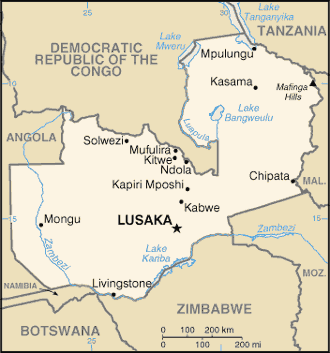Map:

Overview:
The territory of Northern Rhodesia was administered by the South Africa Company from 1891 until it was taken over by the UK in 1923. During the 1920s and 1930s, advances in mining spurred development and immigration. The name was changed to Zambia upon independence in 1964. In the 1980s and 1990s, declining copper prices and a prolonged drought hurt the economy. Elections in 1991 brought an end to one-party rule, but the subsequent vote in 1996 saw blatant harassment of opposition parties. The election in 2001 was marked by administrative problems with three parties filing a legal petition challenging the election of ruling party candidate Levy MWANAWASA. The new president launched a far-reaching anti-corruption campaign in 2002, which resulted in the prosecution of former President Frederick CHILUBA and many of his supporters in late 2003. Opposition parties currently hold a majority of seats in the National Assembly.
The People:
Population: 11,261,795
note: estimates for this country explicitly take into account the effects of excess mortality due to AIDS; this can result in lower life expectancy, higher infant mortality and death rates, lower population and growth rates, and changes in the distribution of population by age and sex than would otherwise be expected (July 2005 est.)
Age structure:
0-14 years: 46.5% (male 2,626,911/female 2,609,857)
15-64 years: 51.1% (male 2,848,402/female 2,904,376)
65 years and over: 2.4% (male 118,043/female 154,206) (2005 est.)
Median age: total: 16.46 years
male: 16.26 years
female: 16.67 years (2005 est.)
Religions:
Christian 50%-75%, Muslim and Hindu 24%-49%, indigenous beliefs 1%
Government Type:
republic
Leader(s) to pray for:
chief of state: President Levy MWANAWASA (since 2 January 2002); Vice President Lupando MWAPE (since 4 October 2004); note - the president is both the chief of state and head of government
Source: The World Factbook
View All Countries